[Report] Aging in the community: Factors associated with home adaptations and receipt of informal care, home care, and community support services among older Canadians

Abstract
Background
Most older Canadians would prefer to stay in their own homes and communities rather than move to long-term care (LTC) facilities. A growing older population, limited LTC capacity, and costs have increased demand for initiatives that enable people to age in their communities for as long as possible.
Data and methods
Data from the 2019/2020 Canadian Health Survey on Seniors were used to estimate the prevalence of four types of supports and services (SSs) that assist with living in the community: home adaptations, informal care, home care, and community support services. Separate multivariable logistic regressions for each SS, stratified by age group (65 to 79 years and 80 years or older), examined associations with need-related factors, enabling resources, and predisposing characteristics.
Results
At 25.0% of 65- to 79-year-olds and 51.9% of those aged 80 years or older, home adaptations were the most prevalent SS used in Canada. Use of home care, community support services and informal care was less common, ranging from 5.5% to 11.6% among Canadians aged 65 to 79 and 17.2% to 33.2% among those aged 80 or older. Nonetheless, substantial proportions of the younger (65.4%) and older (31.8%) age groups reported no SS use. In general, having a poor health status, having impairment, not driving, being older, living alone, having a regular health care provider, and being a woman increased the odds of using SSs.
-
By
Heather Gilmour and Michelle Rotermann (Statistics Canada)
-
Published
Aug 07, 2025
-
Subject Area
- Age-friendly Communities
- Health & Wellness - General
-
Audience
- Government (Politicians, Policy Makers) and Health Authorities
- Service Providers (Non-profits, Community Organizations, Local government)
-
Category
- Research & Reports
